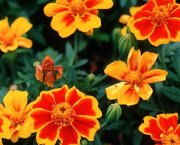|
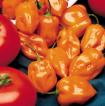 |
People who live in apartments and townhouses without gardens
can grow peppers and other plants on their balconies, patios,
or even in a closet under lights. The peppers can be moved around
easily, transforming the peppers from patio plants to ornamental
houseplants.
They can be rescued from heavy downpours or hail, or moved to
areas of varying light levels. In pots, peppers are easier to
isolate for plant breeding or to produce pure seed. Treasured
varieties can be wintered over in a greenhouse or sunroom and
returned to the garden the following year. |
What to grow peppers in
Virtually any container can be used to grow peppers. If the reason
for using containers is to expand the size of the garden rather than
eventually to bring the plants indoors, then size and appearance is
not a problem and the gardener can use fairly large containers such
as plastic trash cans, wooden boxes or barrels, styrofoam picnic coolers,
and the large plastic, fiber, or metal pots used by greenhouses for
shrubs and trees. The ideal size for peppers is five gallons or larger
for outdoor growing.
If, however, the purpose of growing peppers in containers is to winter
them over, to turn them into perennials, or for breeding, then smaller,
more attractive containers should be used. We have had peppers in containers
ranging in size from a plastic pot with a 4-inch diameter to a barrel
with a 22-inch diameter. With a few exceptions, the larger the container,
the larger the pepper plant will grow. Smaller containers restrict root
growth, which limits foliage and flower production but they are recommended
for gardeners wishing to grow bonzai peppers. Remember that smaller
containers will require more frequent watering, and that lighter-colored
pots will reflect more solar energy and keep the roots of the plant
cooler.
We believe that the smaller-podded varieties adapt best to
container growing--especially to the smaller pots. . Good drainage
is essential regardless of the type of containers chosen for growing
peppers. The containers should have large drain holes. To prevent
soil from washing out of the holes, plug them with irregularly
shaped stones.
Some early sources suggest placing a 3-inch layer of gravel to
aid in drainage, but this practice is discredited today. Do not
place the container in a jardinere or in a saucer because of the
risk of the roots sitting in water. Indoors, of course, saucers
are a necessity, so just make sure the pot doesn't sit in water. |
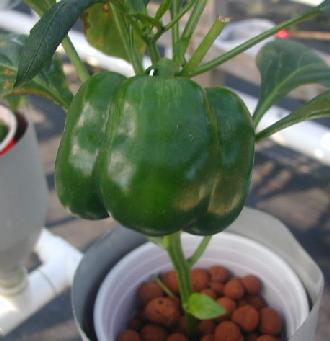 |
One of the biggest problems with container gardening is the tendency
for the plants to dry out and wilt between regular waterings. The major
cause of the quick drying is plant transpiration, which is greater than
one might expect when the plant has a well developed root system. Another
cause of drying is evaporation from the top of the soil, which can be
controlled with a mulch of grass clippings--but then it's hard to see
how wet the soil is. The third cause is the type of soil chosen for
the container.
It is commonly believed that commercial potting soil is the best choice
for containers because many garden soils contain too much clay for use
in pot. However, commercial potting soils often contain so much sand,
perlite, and milled sphagnum moss that they drain too fast and dry out
too quickly.
Some gardeners have had success with simply digging soil out of the
garden and putting it in a pot. Most pepper gardeners add some garden
soil to a mix that includes commercial potting soil and other soil expanders.
We have had good luck with the following formula: 1 part perlite, 1
part sand, 1 part vermiculite, 3 parts commercial potting soil.
Location
Outdoors, peppers in containers seem to do best in partial shade or
in locations receiving full sun only in the morning. There is a tendency
for pots in full sun to absorb solar radiation and heat up the roots
too much. However, if the pots are quite large, painted white or aluminum
to reflect solar energy, and are well-mulched, many varieties will thrive
in full sun. Indoors, the plants will be partially shaded by the movement
of the sun, so place them in the sunniest window. In the summer, it's
usually an east or west window; in the winter, a south window is best.
Fertilizing
Peppers in pots generally need a little more feeding than those outdoors
growing in aged manure. About once a week early in the growing season,
use a balanced liquid fertilizer, such as 10-10-10, diluted even more
than the instructions suggest. Fish emulsion seems to work well for
organic gardeners. A good slow-release fertilizer is Osmocote, which
does not burn the plants and provides a steady supply of nutrients.
If the growth of the potted pepper seems more vigorous than that of
the same variety in the garden, or if blossoms are dropping, stop using
the fertilizer. If blossom drop continues, too much nitrogen has been
applied, and the pot should be flushed by running a lot of water through
it.
Problems
One of the biggest problems with growing peppers indoors is pets. The
plants are chewed by cats, dogs, and birds. Some gardeners put netting
over their peppers to keep the cats off, but then they have hidden their
favorite plants. Another problem with growing peppers indoors or in
greenhouses is that they are more susceptible to the usual houseplant
attackers: spider mites, whitefly, and aphids. The best control is to
wash the plants at least once a week with soapy water, then rinse them.
You can even put them under the shower to spray them off. Be sure to
wash the underside of the leaves.
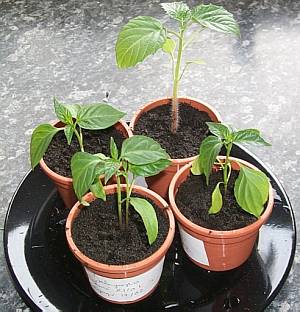 | Seed and Plant Sources
By far, the best selection of chile seeds is Seed Saverís Exchange,
where gardeners exchange their seeds with other hobbyists. You have
to be a member to participate. Reach them at www.seedsavers.org or 563-382-5990.
Another good source is the Chile Seed and Plant Ring at http://ushotstuff.com/HotSeeds.htm,
which is a group of 25 linked sites all selling seeds or plants. To
find even more seed supplies, visit www.google.com and do an advanced
search for the phrases "chile seeds" and "pepper seeds." |
There are at least two companies selling a wide variety of chile bedding
plants: Cross Country Nurseries, at www.chileplants.com and The Chile
Woman at www.thechilewoman.com. We have ordered from both of these companies
and the plants arrived in very good condition and all survived. In Europe,
seeds for many varieties are available online at the Pepperworld Hot
Shop in Germany (site is in German language).
Fresh Tomatillo Salsa with Serranos
In Mexico, all sauces are salsas, regardless of whether or not they
are cooked. But in the U.S., a salsa usually refers to an uncooked sauce.
This is one of the simplest--yet tastiest--uses of serrano chiles. Serve
this as a dip for chips or as a marinade and basting sauce for grilled
poultry and meat.
- 1 pound fresh green tomatillos
- 3 tablespoons finely chopped red onions
- 2 serrano chiles, seeds and stems removed, minced
- 1 small bunch cilantro, coarsely chopped
- Juice of 1 lime
- 1 to 2 tablespoons olive oil (optional)
- Sugar to taste (optional)
| 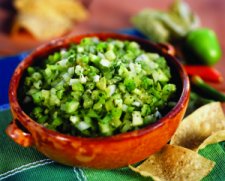 |
Husk the tomatillos and wash them thoroughly under very hot water.
Cool under running water, and coarsely puree in food processor or blender.
Add the onions, serrano chiles, cilantro, and lime juice and pulse until
coarsely chopped.
Remove the bowl and add olive oil if you wish to adjust the consistency.
Add some sugar if the tomatillos are too sour.
Yield: About 2 cups |
|

 |
